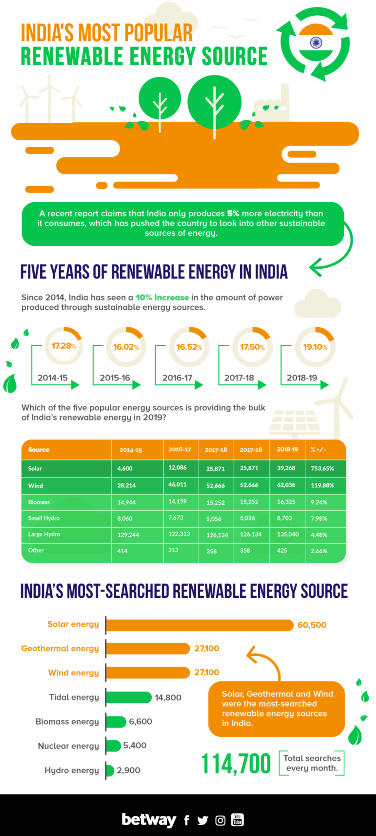According to research conducted in the early 1960s, it was found that if all the energy resources are to be used at current speed, then we will run out of it in 150 years. The advent of the industrial revolution increased the production and use of fossil fuels. This is an essential source of energy for India. More than 65% of India’s energy resources are dependent on non-renewable energy sources. Therefore, it becomes crucial for the nation to move into the field of renewable energy resources. You can tap into this infographic by Betway Live Casino to have a detailed insight of the same:
The country has taken many steps in this venture. Being a developing nation, the country has many liabilities, yet it takes the issue of the environment seriously. This is evident for the plans the Government of India has for expanding into this domain.
Energy production has grown by 10% since 2014 from renewable sources of energy. The most prominent energy resources in India are:
Solar Energy
The goal of the present government is to tap the solar energy falling on India and create a 25 GigaWatt energy surplus. Solar is by far the most useful and energy-efficient resource. The cost of setting up a solar power plant is a one-time investment. Once set-up, the power plant can run continuously to generate electricity from the sunlight falling on it. Therefore, it does not incur any running costs like a thermal or nuclear power plant.
The solar power plant is costly to set-up initially. The government addresses this problem, and the additional subsidy is provided to firms. More private manufacturers will reduce costs. Barren lands are being converted into solar farms, and rural electrification has increased because of solar power plants.
Wind Energy
India has enormous untapped potential for wind energy generation. This particular energy resource was untapped until a few years ago. Now investments have come up, and new wind farms are being commissioned. The rich coastline of more than 7,000 km is an ideal point. The westerlies and the receding monsoon winds can be a significant source of energy generation. The installation of wind turbines also employs the local youth. The wind farms need operators and maintenance professionals.
Therefore, the backward areas that are not well connected to the mainstream can get connected. The installation of this renewable source of energy provides a double advantage for the country.
Biomass Energy
There are not one but several advantages of using biomass energy. First, the set-up cost of a biomass plant is meager. This plant can be commissioned in miniature forms in villages, which is very cost-effective.
Secondly, the biomass uses the waste generated in the towns and creates energy from it. Thus, the waste product is being used to generate energy by biomass.
Hydro Energy
The hydro energy is used for irrigation and flood prevention as well as for energy generation. Small hydro plants are constructed in hills where they can power small towns and villages. Large hydropower plants can generate a megawatt of energy.
The cost of setting up a hydropower plant is high and has an environmental impact. The power plant is set up in large areas where the storage of water is possible.




